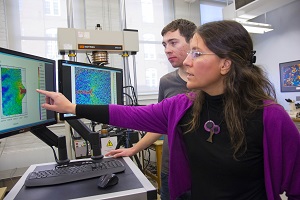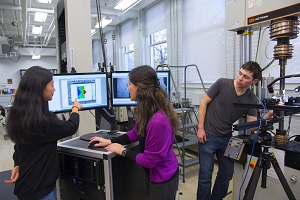
With an eye toward making air travel safer and more cost-effective, a research team at Worcester Polytechnic Institute (WPI) is expanding the fundamental understanding of how stress and fatigue cause microscopic damage to form in metal components.
The team is translating that knowledge into new tools and technology to detect the formation of cracks in aircraft components and monitor their progression—and even predict when a crack will be serious enough to require servicing. The work will apply to military and commercial aircraft, and has the potential to keep military aircraft in service longer while improving safety and on-time performance for commercial airlines.
Funding for this research comes from the U.S. Army Research Office through the highly competitive Defense University Research Instrumentation Program (DURIP). While the Army has awarded $239,000 for this work, industry has also pitched in an additional $60,000. The money allows Diana Lados, Milton Prince Higgins II Distinguished Professor of Mechanical Engineering and founding director of the university's Integrative Materials Design Center (iMdc), to acquire a sophisticated nondestructive evaluation system that uses eddy-current sensor arrays and other advanced tools to study the microstructure and behavior of metals.

Specifically, Lados and her team will conduct comprehensive testing and characterization studies to understand and monitor how tiny cracks are initiated and then grow in metal components as they are subjected to repetitive (or cyclic) strains and stresses similar to those that wings, fuselages, and other aircraft components experience in service. Using a new imaging system, the researchers are able to view the initiation and propagation of cracks at the micro-scale while metal samples are stressed in a servo-hydraulic testing machine. These fatigue cracks can be detected both at the surface of metal samples and also by using electromagnetic induction, within the metal microstructure.
"What we will learn is how the microstructures of these materials influence crack initiation and growth phenomena," said Anthony Spangenberger '12, a PhD candidate who joined the iMdc team in 2012. "We can identify damage hot spots in the microstructure that will help us better engineer our materials for optimized structural performance."
With the knowledge gained through laboratory testing, advanced characterization, and computational modelling, the team is looking to develop new lightweight metal alloys that are more resistant to cracking, or in which small cracks are less likely to expand into larger fissures that would require a component to be repaired or replaced. In addition, they hope to be able to develop algorithms that will make it possible to predict, based on the state of stress and the rate of crack progression in a component, when servicing will be required.
"By understanding the behavior of the materials, we can swap out heavier steel components for lighter aluminum alloys, which are going to behave reliably because we will design better for fatigue and crack growth resistance under different operating conditions," said Spangenberger.
Lados said the technology she and her team are using in the lab can be incorporated into sensors that could be attached to critical components in airplanes to detect and monitor fatigue damage in real time. Currently, she said, aircraft are taken out of service at set intervals to be inspected for fatigue-related cracking. By monitoring aircraft components continuously, and employing the predictive algorithms being developed in the Lados lab, it may be possible to schedule aircraft servicing only when needed, which could significantly reduce costs and out-of-service time.
"This technology, with its multiple uses, would bring important advancements to the materials and aircraft industries, contribute to increased safety and on-time performance, and undoubtedly save time and money for aircraft operators and, ultimately, the airlines," said Lados. "I think this research will go a long way to enhancing the way the aircraft industry views its inspection and monitoring systems."
.jpg)
The current research builds on the intellectual know-how, established infrastructure, and advanced materials testing and characterization capabilities at WPI and iMdc. The equipment can also be paired with a system of high-speed cameras with quantitative stereo imaging and digital image correlation acquired by WPI last year through a $467,000 Major Research Instrumentation grant from the National Science Foundation on which Lados was a co-principal investigator.
"The new instrumentation can be integrated in unique ways with the equipment from our earlier NSF grant," said Lados. "I expect the combined capabilities and increased flexibility will provide interesting results for damage detection and monitoring in two- and three-dimensions on both laboratory specimens and actual components." Lados noted that this technology can be applied to a variety of materials fabricated by both conventional and novel processes, and will also play an important role in her team's work on additive manufacturing, friction-stir welding, cold-spray processing, and rapid product qualification and repair.
This is the fifth major award Lados has received over the past three years. Last fall, she received a three-year, $424,000 award from the National Science Foundation (NSF) for work on a novel manufacturing method for lightweight metals. In 2012 she received a five-year, $525,000 NSF CAREER Award to engineer and accelerate the use of aluminum alloys in structural transportation applications. A recent large five-year industrial grant will fund the development of a new methodology for materials and damage characterization in structural components that combines digital image correlation, electron backscattered diffraction, and tomography.
She also receives significant annual funding from the U.S. Army and through iMdc, a large industry-government-university research and education alliance that she established and has led at WPI for nearly 10 years. The center is dedicated to advancing the state of the art and practice in sustainable materials-process-component design and manufacturing for high performance and reliability, and its more than 30 members include some of the world's largest manufacturing companies, several government organizations, and many national laboratories.
Lados has published 80 articles and two book chapters and delivered more than 150 conference and industrial presentations and invited lectures. She has been widely recognized for this work, receiving numerous awards from professional and scientific organizations, which fittingly include the inaugural Constance Tipper Silver Medal from the World Academy of Structural Integrity for “her outstanding and seminal research, her technical accomplishments and pioneering contributions with worldwide impact in the fields of metal fracture and fatigue, and her successful efforts to transfer knowledge to industrial applications.”
